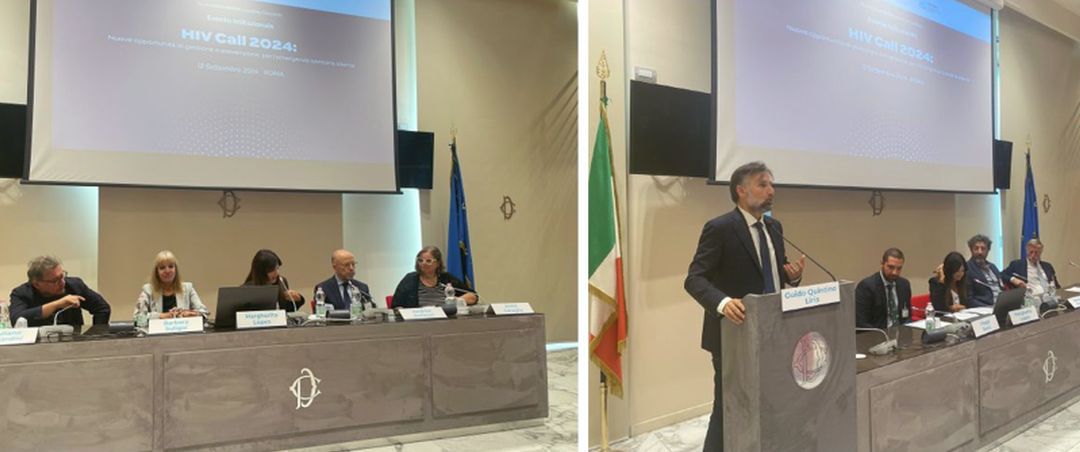ROME (ITALPRESS) – HIV remains one of the most pressing public health challenges. Looking at the numbers in our country, the picture of the emergency is very clear: in just 20 years, the number of people with HIV has doubled, from about 70,000 cases in 2000 to more than 120,000 people diagnosed with the virus in 2023.In Italy today, HIV represents an epidemic, silent and talked about too little: the number of HIV-positive residents increases every year, despite the fact that the incidence of the infection is decreasing. This is mainly due to the lack of information, which leads to late diagnosis and further delays the ability to best combat the spread of the virus.Although the numbers are alarming, therapeutic evolution and innovation represent great hope, for people at risk of contracting the virus and for people with HIV. The therapeutic tools available today make it possible to significantly reduce the risk of infection as well as serious outcomes, making HIV a treatable chronic condition.A significant step forward is the evolution of preventive drug treatments.According to UNAIDS, by 2025, 86 percent of people with HIV are expected to achieve an undetectable viral load, and 95 percent of people at risk should have access to pre-exposure prophylaxis (PrEP).This new slow-release strategy represents a significant advance in HIV prevention over traditional daily prophylaxis. Long-Acting Pre-Exposure Prophylaxis (PrEP), administered intramuscularly every two months, ensures a prolonged and constant release of the active ingredient into the bloodstream, maintaining optimal therapeutic levels to fight infection.In light of these premises, the event ‘HIV Call 2024: new management and prevention opportunities for the silentè health emergency’ was held today at the Chamber of Deputies, at the initiative of the Honorable Luciano Ciocchetti and organized by Cencora-Pharmalex. The meeting, organized under the patronage of Parliamentary Intergroup One Health, Istituto Superiore di Sanità, SIMaST and SIMIT, and with the unconditional contributionof ViiV Healthcare Italia, represents an important opportunity for discussion among clinicians, institutions and patient associations, focused on therapeutic innovations and the challenges of HIV prevention.During the event, participants explored how innovativistial treatments are transforming the management of HIV, ensuring excellent results when diagnosis is timely.Luciano Ciocchetti, Vice-Chairman XII Committee on Social Affairs, Chamber of Deputies and coordinator Parliamentary Intergroup One Health, stressed, “As co-chair of the Parliamentary Intergroup One Health, which we started last year and which aims to promote an integrated approach of human, animal and environmental health, it is crucial for me to emphasize how necessary it is to keep the spotlight on HIV. To achieve the WHO goal of eradicating the virus by 2030, it is necessary for policymakers to focus their attention on prevention and equitable access to the best treatment. It is only through synergistic collaboration between national and regional institutions, the scientific community, and associations of patients or affected communities that we can truly make significant progress for people at risk of contracting the virus and those already affected. “The updated WHO guidelines emphasize the importance of making Long-Acting PrEP widely available, recognizing its essential role in protecting public health. According to the ECDC’s 2021 report, Italy ranks 16th out of 28 countries for the number of people who have received PrEP at least once. “Long-Acting treatment helps overcome stigma and self-stigma associated with both the disease and treatment and reduces the likelihood of treatment discontinuation, a key element for communicable diseases, particularly HIV where U = U is the cornerstone of any preventive strategy. It also offers numerous advantages: it improves the patient’s quality of life, simplifies treatment management, and offers a unique opportunity related to periodic dosing, as it is also useful for the overall monitoring of the person with HIV,” said Andrea Antinori, Director of Clinical and Research Department Infectious Diseases National Institute for Infectious Diseases Lazzaro Spallanzani IRCCS, Rome – “Clinical trials show that preventive strategies and Long-Acting care promote greater adherence to treatment, reducing the risk of treatment failure and increasing the effectiveness of prevention from infection. The injectable formulation improves drug bioavailability and reduces interactions with other drugs, offering a more practical and effective therapeutic option,” added Massimo Andreoni, Professor Emeritus of Infectious Diseases, University of Rome “Tor Vergata,” Scientific Director of the Italian Society of Infectious and Tropical Diseases (SIMIT).A joint effort at the clinical level and at the social and institutional level is essential to respond to the needs of people with HIV; who today are no longer to be considered a danger of infection, but who need special attention like all patients with chronic disease.Giuliano Rizzardini, Director and Head of the Infectious Diseases Department 1 at the Polo Universitario Ospedale Luigi Sacco in Milan, confirms – “Compared to 15-20 years ago, the picture has really changed. The case of HIV has been an exceptional path in the history of medicine, if we compare the years when the virus was discovered to the current situation. We must continue to have the courage to change and thus improve the paradigms of care. We need to work on the underground and break down the barriers of stigma and taboos by publicizing new preventive strategies and treatment opportunities.” and continues – “Once the underground is intercepted, and the disease is diagnosed early, antiretroviral therapy is definitely effective. Not to mention the advantage of the new Long-Acting therapies, which although taken for life, provide for time-dilated administration and thus raise the quality of life. “During the event, the Position Paper “Long-Acting (LA) Drugs: New Perspectives in HIV Management and Prevention” was presented, outlining strategies for HIV management and prevention, with a special focus on therapeutic innovations. In this context, the need to overcome barriers related to stigma and to make innovative therapies, such as Long-Acting therapies, accessible to all patients was discussed extensively. “Today, the Ministry of Health is facing major public health challenges, and it is important to work in a One Health vision, integrating innovation and programming. In the fight against HIV, it is essential to treat people with HIV while simultaneously implementing prevention strategies. Achieving the WHO goal of eradicating the HIV epidemic by 2030 would represent an investment both economically and in terms of quality of life and complications avoided for patients,” added Francesco Saverio Mennini, head of the Department of Planning, Medical Devices, Drugs and Policies in Support of the National Health Service, Ministry of Health.It is crucial to understand and capitalize, today, on the concept of Long-Acting (LA) in order to contextualize the best strategy to combat the virus, also in light of the new quality-of-life pluses that Long-Acting represents.Realizing this goal means recognizing its role-in all its forms-as an essential element of public health protection.-photo press office Pharmalex -(ITALPRESS).

